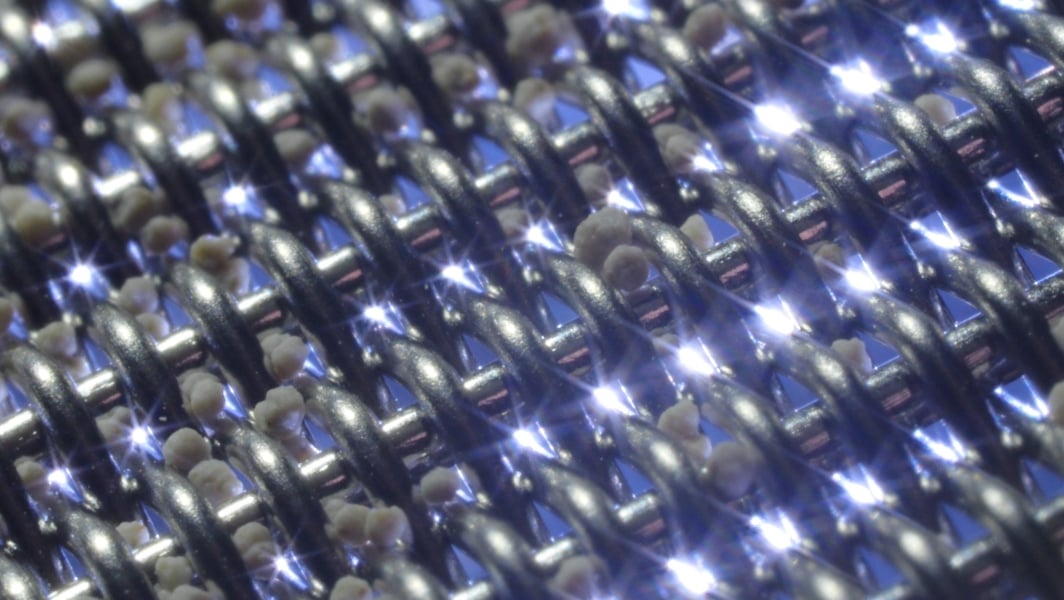Monitoring and Renewing Mesh Used in Hydrogen Production
Keeping wire mesh in peak condition is critical to sustaining the efficiency and safety of hydrogen production lines. Over time, even the most durable filtration media can degrade, leading to pressure drops, compromised purity levels, or costly unexpected downtime.
Without constant monitoring, operators may miss the early signs of wear that signal declining performance.
Mesh used in hydrogen applications faces demanding operating conditions, from exposure to high pressures and corrosive gases to constant particle loading. These factors accelerate fatigue and wear, making routine inspection and performance tracking essential.
By establishing reliable monitoring practices, facilities can better anticipate replacement needs before failures occur.
At W.S. Tyler, our commitment is to advancing filtration and woven wire mesh solutions that help industries operate more efficiently and reliably. With over 150 years of engineering expertise, we support operators in maintaining high standards of safety, performance, and consistency.
In this article, we’ll explore how to evaluate mesh performance in hydrogen systems, recognize key indicators of wear, and determine the right time to replace mesh filters. By applying these practices, you’ll not only safeguard production integrity but also extend the service life of your equipment.
Understanding Mesh Performance in Hydrogen Filtration
The performance of wire mesh in hydrogen production is measured by how effectively it balances filtration precision with consistent flow. An optimal mesh ensures that contaminants are captured without creating excessive resistance, allowing hydrogen to pass through at the desired rate.
Over time, small shifts in this balance can indicate that the mesh is beginning to degrade.
Factors such as mesh opening size, wire diameter, and weave pattern all influence how the filter performs under real-world operating conditions. When these variables interact with pressure, temperature, and particle load, they create unique performance characteristics that must be carefully monitored.
Looking to learn more about optimizing your mesh opening sizes? Learn more in our article below:
Even slight blockages or structural damage can reduce efficiency, raising energy costs and increasing strain on connected equipment. For industries that depend on reliable hydrogen purity, these inefficiencies can lead to downtime or compromised product quality.
By understanding the relationship between mesh properties and system performance, operators gain the insight needed to detect changes early. This knowledge forms the foundation for building proactive maintenance and replacement strategies that protect both system reliability and long-term productivity.
Signs of Wear That Impact Efficiency
Over time, wire mesh in hydrogen production lines is exposed to constant pressure cycles, high flow rates, and contaminant loads that gradually reduce its effectiveness. While mesh degradation is inevitable, knowing the early warning signs allows operators to act before performance drops significantly.
One of the most common indicators is a noticeable pressure drop across the filter. As mesh becomes clogged with fine particles, resistance to flow increases, forcing pumps and compressors to work harder. This not only decreases efficiency but also raises energy consumption.
Another signal is inconsistent hydrogen purity levels. If contaminants bypass or slip through the mesh, downstream equipment may show signs of fouling, sensor drift, or catalytic degradation.
These issues often point to stretched, damaged, or fatigued mesh openings.
Physical wear should also be monitored. Frayed wires, broken strands, or visible deformation compromise structural integrity, leading to uneven flow and reduced filtration accuracy. Left unchecked, this can result in unexpected system shutdowns.
By recognizing these warning signs early, operators can schedule interventions that prevent downtime, safeguard hydrogen purity, and extend the life of their production systems.
When Your Mesh Needs Replaced
Even with regular monitoring and maintenance, wire mesh has a finite service life. Knowing the right time to replace it is critical for protecting both system performance and operational safety.
A general rule of thumb is to replace mesh when cleaning or backflushing no longer restores pressure levels. If clogs persist despite maintenance, the mesh structure may be too compromised to function effectively.
Replacement is also necessary when hydrogen purity cannot be maintained despite process adjustments. Contaminant breakthrough is a clear signal that mesh openings have widened or deformed beyond acceptable limits.
For high-demand applications, operators should also follow usage-based replacement schedules. Tracking operating hours, flow rates, and contaminant loads allows for predictive replacement before issues arise, reducing the risk of unexpected shutdowns.
Lastly, mesh showing physical damage such as cracks, tears, or wire fatigue should be replaced immediately, regardless of filtration performance. Structural weakness not only reduces efficiency but may also release wire fragments into the system, creating more severe problems downstream.
By establishing clear replacement triggers, operators can ensure their hydrogen production lines continue to run efficiently, safely, and reliably.
Extending System Reliability with Timely Mesh Management
Maintaining efficiency in hydrogen production hinges on two things: knowing how your mesh is performing and recognizing when it’s time to replace it. By tracking pressure drop trends, flow stability, purity drift, and visible wear, you can prevent surprise failures and keep downstream components protected.
Next, put a simple framework in place: establish a baseline performance, schedule routine inspections, log flow over time, set clear replacement triggers, and document every changeout. Turning these checkpoints into habit makes uptime predictable and quality consistent.
At W.S. Tyler, our mission is to make the world cleaner and safer through precision-engineered wire mesh solutions. With over 150 years of expertise, we help hydrogen producers select the right materials, define inspection protocols, and plan replacement cycles that support long-term reliability.
Interested in learning more about maintaining wire mesh? Discover more in the article below:
About Dylan Polz
Dylan is a Content Writer with 2 years of experience in marketing and SEO. Passionate about learning and strengthening his writing skills, he is currently expanding his expertise in particle analysis and woven wire mesh technologies. With a strong belief in the power of information to drive positive change, his goal is to develop content that supports cleaner, safer solutions across all industries.



